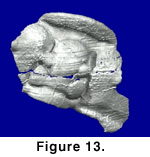EXTENSIONS OF RECONSTRUCTION TECHNIQUES
Whole fossil reconstructions
 Reconstructions
from a single grinding run typically comprise just part of a fossil, as grinding
normally commences from the plane along which the nodule was originally
fractured. Reconstructions of entire fossils may be obtained by gluing part and
counterpart together before sawing to size so that the entire fossil can then be
ground through as one unit. However, this approach can produce artifacts from
imperfect alignment of the glued surfaces or from the glue itself. Alternatively
and more satisfactorily, part and counterpart can be reconstructed separately
and reassembled digitally before rendering. Figure
13 is an example of a whole fossil reconstructed in this way.
Reconstructions
from a single grinding run typically comprise just part of a fossil, as grinding
normally commences from the plane along which the nodule was originally
fractured. Reconstructions of entire fossils may be obtained by gluing part and
counterpart together before sawing to size so that the entire fossil can then be
ground through as one unit. However, this approach can produce artifacts from
imperfect alignment of the glued surfaces or from the glue itself. Alternatively
and more satisfactorily, part and counterpart can be reconstructed separately
and reassembled digitally before rendering. Figure
13 is an example of a whole fossil reconstructed in this way.
Dissection of models
Reconstructions of portions of a fossil, or of a subset of the structures present, are often of great utility. A strength of the volume-based approach described here is the ease with which such ‘dissected’ reconstructions can be prepared. Copies of the appropriate slice images are simply manipulated using image editing software to remove structures or portions of the fossil that are not required (see Appendix 1, section 3), and are then rendered in the normal way. Slice videos and pre-dissection three-dimensional reconstructions provide the ideal tools to guide such dissection work, and ensure that unwanted structures are removed accurately.